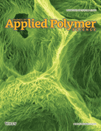Design of zero–zero-birefringence polymers in methacrylate copolymer systems containing trichloroethyl methacrylate
Abstract
Polymers that exhibit neither orientational nor photoelastic birefringence, called zero–zero-birefringence polymers, are candidate materials for preparing optical components of liquid crystal displays (LCDs). Analyzing the birefringences for various methacrylate polymers is an issue of current importance in developing zero–zero-birefringence polymers with appropriate characteristics for LCDs. The researchers have investigated different types of birefringence for poly(2,2,2-trichloroethyl methacrylate) (PTCEMA) and have shown that PTCEMA exhibits negative orientational and photoelastic birefringences. By using TCEMA as a comonomer, a zero–zero-birefringence polymer having much higher glass transition temperature (Tg) compared with previous researches has been prepared by ternary copolymerization. Moreover, the researchers have fabricated zero–zero-birefringence polymers in a quaternary system containing TCEMA. The property analyses indicate that Tg can be controlled while maintaining the zero–zero-birefringence property, which shows that designing a quaternary zero–zero-birefringence polymer permits selective synthesis with the most appropriate characteristics. © 2013 Wiley Periodicals, Inc. J. Appl. Polym. Sci., 2013




